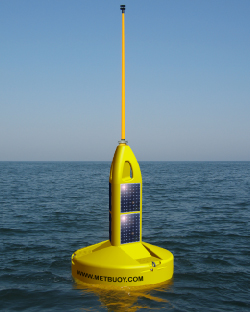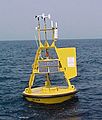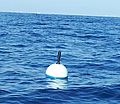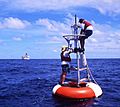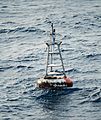Buoy facts for kids
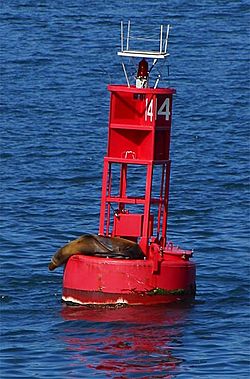
A buoy is a floating beacon or marker that is placed in the sea. It can have many different purposes, which determine whether the buoy is anchored (stationary) or allowed to drift. The word is most commonly said (as in buoyant), but in American English it is often pronounced.
One of the many purposes are keeping the people safe from strong currents. Buoys mark the end of the safety zone, if people swim past the buoys they will be likely to be dragged out to sea.
Types
- Sea mark – aids pilotage by marking a maritime channel, hazard and administrative area to allow boats and ships to navigate safely. Some navigational buoys are fitted with a bell or gong, which sounds when waves move the buoy
- Lifebuoy – used as a life saving buoy designed to be thrown to a person in the water to provide buoyancy. Usually has a connecting line allowing the casualty to be pulled to the rescuer
- Submarine communication buoys – used for release in case of emergencies or for communication
- DAN buoy – has several meanings:
- A large maritime navigational aid providing a platform for light and radio beacons
- A lifebuoy with flags used on yachts and smaller pleasure craft
- A temporary marker buoy used during Danish seine fishing to mark the anchor position of a net.
- A temporary marker buoy set by danlayers during minesweeping operations to indicate the boundaries of swept paths, swept areas, known hazards, and other locations or reference points.
- A temporary marker buoy set to mark a man overboard position.
- Large Navigational Buoy (LNB or Lanby buoy) is an automatic buoy over 10m high equipped with a powerful light monitored electronically as a replacement for lightships. A LNB may be marked on charts as a "Superbuoy."
- Sonobuoy – used by anti-submarine warfare aircraft to detect submarines by SONAR
- Surface marker buoy – taken on dives by scuba divers to mark their position underwater
- Decompression buoy – deployed by submerged scuba divers to mark their position underwater whilst doing decompression stops
- Shot buoy – used to mark dive sites for the boat safety cover of scuba divers so that the divers can descend to the dive site more easily in conditions of low visibility or tidal currents and more safely do decompression stops on their ascent.
- Safe water mark or Fairway Buoy – a navigational buoy which marks the entrance to a channel or a nearby landfall
- Emergency Wreck Buoys – Emergency Wreck Buoys provide a clear and unambiguous means of marking new wrecks. This buoy is used as a temporary response, typically for the first 24–72 hours. This buoy is coloured in an equal number of blue and yellow vertical stripes and is fitted with an alternating blue and yellow flashing light. This has come about due to the collisions which occurred in the Dover Straits in 2002 when vessels struck the new wreck of the MV Tricolor.
- lateral marker buoy
- Mooring buoys – used to keep one end of a mooring cable or chain on the water's surface so that ships or boats can tie on to it
- Tripping buoys – used to keep one end of a 'tripping line' on the water's surface so that a stuck anchor can more easily be freed
- Weather buoys – equipped to measure weather parameters such as air temperature, barometric pressure, wind speed and direction and to report these data via satellite radio links such as the purpose-built Argos System or commercial satellite phone networks to meteorological centres for use in forecasting and climate study. May be anchored (moored buoys) or allowed to drift (drifting buoys) in the open ocean currents. Position is calculated by the satellite. Weather buoys are sometimes referred to as ODAS buoys or Ocean Data Acquisition Systems and may be marked on charts as "Superbuoys."
- Tsunami buoys – anchored buoys that can detect sudden changes in undersea water pressure are used as part of tsunami warning systems in the Pacific Tsunami Warning Center and Indian Oceans.
- Spar buoy – a tall, thin buoy that floats upright in the water, e.g. R/P FLIP.
- Profiling buoy – specialized models which adjust buoyancy so that they will sink at a controlled rate to 2,000 metres below the surface while measuring sea temperatures and salinity. After a time, typically 10 days, the buoy returns to the surface, transmits its data via satellite, and then sinks again. See Argo (oceanography).
- Ice marking buoys – used for marking ice holes in frozen lakes and rivers, so that snowmobiles do not drive over the holes.
- Marker buoys – used in naval warfare, particularly anti-submarine warfare, is a light-emitting or smoke-emitting, or both, marker using some kind of pyrotechnic to provide the flare and smoke. It is commonly a 3-inch (76 mm) diameter device about 20 inches (500 mm) long that is set off by contact with seawater and floats on the surface. Some markers extinguish after a set period and others are made to sink.
- Lobster trap buoys – brightly colored buoys used for the marking of lobster trap locations so the person lobster fishing can find their lobster traps. Each lobster fisherman has his or her own color markings or registration numbers so they know which ones are theirs. They are only allowed to haul their own traps and must display their buoy color or license number on their boat so law enforcement officials know what they should be hauling. The buoys are brightly colored with highly visible numbers so they can be seen under conditions when there is poor visibility like rain, fog, sea smoke, etc.
- Wave buoy – used to measure the movement of the water surface as a wave train. The wave train is analysed to determine statistics like the significant wave height and period, and wave direction.
- Target buoy – used to simulate target (like small boat) in live fire exercise by naval and coastal forces, usually targeted by weapons (medium size) like HMG's, rapid fire cannons (20 or so mm), autocannons (bigger ones up to 40 and 57mm) and also anti-tank rockets.
- Wreck buoy – a buoy to mark a wrecked ship to warn other ships to keep away because of unseen hazards.
- Self-locating datum marker buoy (SLDMB) – A 70% scale Coastal Ocean Dynamics Experiment (CODE)/Davis-style oceanographic surface drifter with drogue vanes between 30 and 100 cm deep. This particular surface drifter is designed specifically for deployment from a U.S. Coast Guard vessel or airframe for search and rescue. Since the SLDMB has a very small surface area above the ocean surface and a high underwater surface area, there is very little leeway in response to the direct forcing of winds and waves.
- The space buoy is a common element in science fiction that refers to a stationary object in outer space that provides navigation data or warnings about that particular area.
- Buoy racing is the most prevalent form of yacht racing
Images for kids
-
NOAA Weather buoy
-
Children playing on a buoy in the Volga
-
A buoy beached at Sebastian Inlet State Park.
-
Gas buoy stranded on land after 1915 Galveston Hurricane, near Texas City, Texas
-
Starboard lateral Buoy (Lateral mark - Region B - IALA ) as Channel Marker Buoy at "Río de la Plata" river, Buenos Aires, Argentina
-
A buoy off the coast of Whitby, North Yorkshire
See also
 In Spanish: Boya para niños
In Spanish: Boya para niños


